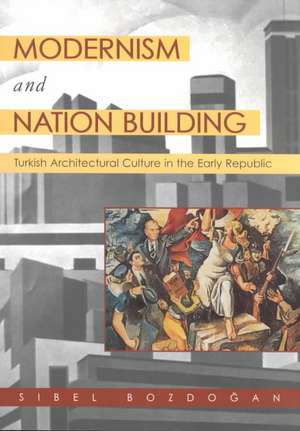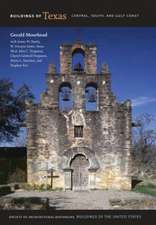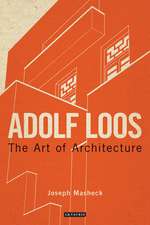Modernism and Nation Building – Turkish Architectural Culture in the Early Republic: Modernism and Nation Building
Autor Sibel Bozdoganen Limba Engleză Paperback – 30 apr 2002
Winner of the M. Fuat Koprulu Book Prize in Turkish Studies sponsored by the Turkish Studies Association
With the proclamation of the Turkish republic by Mustafa Kemal Ataturk in 1923, Turkey's political and intellectual elites attempted to forge from the ruins of the Ottoman Empire a thoroughly modern, secular, European nation-state. Among many other public expressions of this bold social experiment, they imported modern architecture as both a visible symbol and an effective instrument of their modernizing agenda. They abandoned the prevailing Ottoman revivalist style and transformed the entire profession of architecture in Turkey according to the aesthetic canons and rationalist doctrines of European modernism.
In this book, the architectural historian Sibel Bozdogan offers a cultural history of modern Turkish architecture and its impact on European modernism from the Young Turk revolution of 1908 to the end of the Kemalist single-party regime in 1950.
Drawing on official propaganda publications, professional architectural journals, and popular magazines of the day, Bozdogan looks at Turkish architectural culture in its broad political, historical, and ideological context. She shows how modern architecture came to be the primary visual expression of the so-called republican revolution--especially in the case of representative public buildings and in the idealized form of the modern house. She also illustrates Turkish architects' efforts to legitimize modern forms on rational, scientific grounds and to "nationalize" them by showing their compatibility with Turkish building traditions.
After Ataturk's death in 1938, the initial revolutionary spirit in Turkish architectural culture gave way to nationalist trends in German and Italian architecture and to the inspiration of Central Asian and pre-Islamic Turkish monuments. The resulting departure from the distinct modernist aesthetic of the early 1930s toward a more classicized and monumental architecture representative of state power brought this heroic era of modern Turkish history to a close. Today, when Turkey's project of modernity is being critically reevaluated from many perspectives, this comprehensive survey of Kemalism's architectural legacy is timely and provocative.
Preț: 295.75 lei
Nou
Puncte Express: 444
Preț estimativ în valută:
56.60€ • 58.47$ • 47.10£
56.60€ • 58.47$ • 47.10£
Carte tipărită la comandă
Livrare economică 25 martie-08 aprilie
Preluare comenzi: 021 569.72.76
Specificații
ISBN-13: 9780295981529
ISBN-10: 0295981520
Pagini: 380
Ilustrații: 240 illustrations
Dimensiuni: 180 x 252 x 24 mm
Greutate: 1.19 kg
Ediția:Revised
Editura: MV – University of Washington Press
Seria Modernism and Nation Building
ISBN-10: 0295981520
Pagini: 380
Ilustrații: 240 illustrations
Dimensiuni: 180 x 252 x 24 mm
Greutate: 1.19 kg
Ediția:Revised
Editura: MV – University of Washington Press
Seria Modernism and Nation Building
Recenzii
Bozdogans study of the particular cultural and political circumstances for modernism in Turkey effectively destroys the notion that modern architecture in so-called non-Western cultures was merely an extension of Western developments and opens the door to much-needed parallel studies of modernism worldwide. This is postcolonial writing at its best. -- Choice
Notă biografică
Descriere
A cultural history of modern Turkish architecture and its connections to European modernism.












